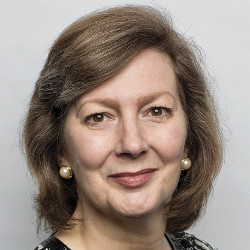
Looking back, I can divide my career into three phases: practicing science, enabling science, and advocating for science. As an undergraduate, I was passionate about chemistry and mathematics, but in my junior year, I discovered how the power of computing could address research questions in chemistry. It comes as no surprise that I pursued a Ph.D. in theoretical and computational chemistry. Wanting access to the world’s fastest supercomputers (Cray, anyone?), I took my first job at a U.S. Department of Energy national laboratory.
By age 38, I was eager to make the transition to the second phase of my career. Although I loved the intellectual stimulation of conducting research, I perceived this career path as a long, straight line stretching into the future. Ultimately, I recognized it would not satisfy my internal yearning to do something more, to have an impact beyond my scientific publications.
In a leap of faith, I moved my family across the country and started a new career at the U.S. National Science Foundation. This proved to be the environment where I could do that undefined something more. I created a cyber-enabled chemical sciences program in the early 2000s and guided funding initiatives in nanotechnology and quantum information science. Eventually, I became a senior executive who enabled science through oversight of a $1.5B portfolio of projects across chemistry, materials science, mathematics, physics, and astronomy.
After President Obama’s election, I received an invitation to be Assistant Director for Physical Sciences in the White House Office of Science and Technology Policy. Although this wasn’t a change I was actively seeking, I took a leave from the National Science Foundation to immerse myself in the world of science policy and explore other ways to contribute to the advancement of science. After the 2013 shutdown of the Federal Government, I was frustrated because I could neither publicly promote increased budgets for my agency nor ask others to do so. At age 57, I was ready to commit to advocating for science. So, I became Chief Operating Officer at the American Association for the Advancement of Science, a multidisciplinary scientific society and publisher of the journal Science.
In this position, I was able to speak out against the restriction on using federal dollars for public health studies on gun violence; share the latest research findings on the detrimental effects of implicit bias in peer review journal articles with scientific society publishers; and advise decision-makers on the role of science in policymaking. I also witnessed the growing politicization of science, including the vocalization of an anti-science mentality from various elected leaders, culminating in my organization’s critical support for the first-ever “March for Science.” Neglect, distrust, and willful disrespect of scientific expertise are horrifyingly evident in the U.S. right now as the mortality rate from Covid-19 climbs. Alas, this is a predictable result of a decades-long assault on scientific expertise.
From my perspective of a long career in science, I can confidently state that our government at local, state, and federal levels cannot function properly without the input of evidence and expertise to policy making. If science were routinely at the table, what different policy solutions might have arisen by now for a host of societal challenges in education, economy, health, housing, energy, and environment? I challenge you to get involved in both science policy and science for policy, by offering potential solutions from research and applications in areas such as data science, robotics, and artificial intelligence. It is vital that you defend science from attacks, celebrate its value to society, and, please, do something more.




Join the Discussion (0)
Become a Member or Sign In to Post a Comment